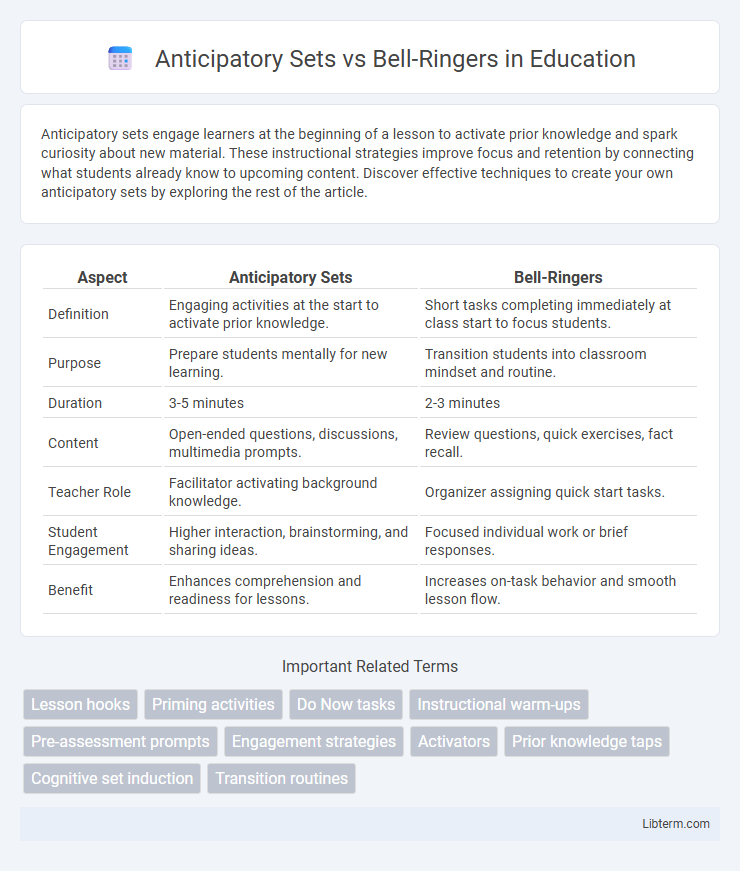Anticipatory sets engage learners at the beginning of a lesson to activate prior knowledge and spark curiosity about new material. These instructional strategies improve focus and retention by connecting what students already know to upcoming content. Discover effective techniques to create your own anticipatory sets by exploring the rest of the article.
Table of Comparison
| Aspect | Anticipatory Sets | Bell-Ringers |
|---|---|---|
| Definition | Engaging activities at the start to activate prior knowledge. | Short tasks completing immediately at class start to focus students. |
| Purpose | Prepare students mentally for new learning. | Transition students into classroom mindset and routine. |
| Duration | 3-5 minutes | 2-3 minutes |
| Content | Open-ended questions, discussions, multimedia prompts. | Review questions, quick exercises, fact recall. |
| Teacher Role | Facilitator activating background knowledge. | Organizer assigning quick start tasks. |
| Student Engagement | Higher interaction, brainstorming, and sharing ideas. | Focused individual work or brief responses. |
| Benefit | Enhances comprehension and readiness for lessons. | Increases on-task behavior and smooth lesson flow. |
Understanding Anticipatory Sets: Definition and Purpose
Anticipatory sets are instructional strategies designed to engage students and activate prior knowledge before introducing new content, creating a mental framework for learning. They often include thought-provoking questions, brief activities, or multimedia stimuli aimed at focusing attention and setting the lesson's tone. The primary purpose of anticipatory sets is to enhance student readiness and improve information retention by connecting new material to existing cognitive structures.
What Are Bell-Ringers? Functions in the Classroom
Bell-ringers are short, engaging tasks or questions given at the very beginning of a class to capture students' attention and prepare them for the lesson. They function as effective tools for activating prior knowledge, promoting classroom routine, and settling students quickly after transitions. These activities also provide formative assessment opportunities, allowing teachers to gauge students' understanding and tailor instruction accordingly.
Key Differences: Anticipatory Sets vs Bell-Ringers
Anticipatory sets engage students by activating prior knowledge and setting the learning purpose before a lesson begins, while bell-ringers are brief, routine tasks designed to focus students' attention at the start of class. Anticipatory sets often involve interactive questions or activities linked to the lesson's objective, whereas bell-ringers typically consist of quick, independent exercises or prompts. The key difference lies in anticipatory sets' role in preparing cognitive readiness compared to bell-ringers' function in classroom management and transition.
Cognitive Engagement: How Both Strategies Prepare Students
Anticipatory sets activate prior knowledge and set a clear learning focus, enhancing students' readiness for new content by stimulating curiosity and cognitive engagement. Bell-ringers prompt immediate brain activity and help transition students into the learning environment, fostering concentration and mental alertness. Both strategies effectively prime students' cognitive processes, optimizing attention and information retention at the start of a lesson.
Designing Effective Anticipatory Sets
Designing effective anticipatory sets involves creating engaging activities that activate students' prior knowledge and set clear learning objectives, enhancing cognitive readiness for new content. Unlike bell-ringers, which are brief tasks performed at the start of class primarily for routine and focus, anticipatory sets are strategically crafted to pique curiosity and connect lessons to real-world contexts. Effective anticipatory sets use multimedia, thought-provoking questions, or interactive discussions to foster student motivation and deeper understanding from the outset.
Best Practices for Using Bell-Ringers Daily
Bell-ringers should be designed to activate prior knowledge and quickly engage students with relevant, bite-sized tasks that connect to the day's lesson objectives, enhancing focus and readiness. Effective daily use of bell-ringers includes consistency in timing, clarity in instructions, and gradual increase in complexity to scaffold learning and build routine. Incorporating brief reflective prompts or quick checks for understanding within bell-ringers supports formative assessment and student accountability.
When to Use Anticipatory Sets or Bell-Ringers
Use anticipatory sets at the beginning of lessons to engage students by activating prior knowledge and setting learning objectives, especially for new or complex topics. Bell-ringers function best as quick, focused tasks to settle students and transition them into learning mode, ideal for routine classroom management and review sessions. Choose anticipatory sets when the goal is to spark curiosity and deeper thinking, whereas bell-ringers are effective for reinforcing previous lessons or preparing students for the day's activities.
Impact on Student Motivation and Participation
Anticipatory sets create curiosity and activate prior knowledge, boosting student motivation by making lessons relevant and engaging from the start. Bell-ringers provide structured, focused tasks that ease students into learning, increasing participation through routine and clear expectations. Both strategies enhance classroom engagement but differ in approach, with anticipatory sets fostering intrinsic motivation while bell-ringers support consistency and readiness to learn.
Examples of Anticipatory Set Activities
Anticipatory set activities include quick interactive exercises such as brainstorming questions, brief discussions, or thought-provoking prompts that activate prior knowledge and engage students at the start of a lesson. For example, a teacher might show a relevant image or pose an open-ended question related to the upcoming topic to spark curiosity and focus attention. These strategies differ from bell-ringers, which typically consist of brief, routine tasks designed to settle students into class rather than actively preview lesson content.
Integrating Bell-Ringers with Lesson Objectives
Bell-ringers effectively activate prior knowledge and prepare students for the lesson by aligning prompts directly with specific lesson objectives, enhancing cognitive engagement. Integrating bell-ringers with learning goals ensures that students focus on key concepts from the outset, promoting coherence and depth in understanding. This strategy maximizes instructional time by seamlessly bridging review with new content, reinforcing targeted skills and knowledge.
Anticipatory Sets Infographic

 libterm.com
libterm.com